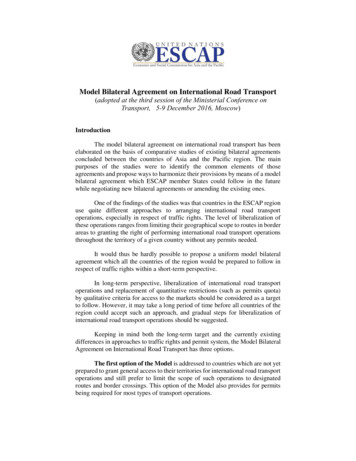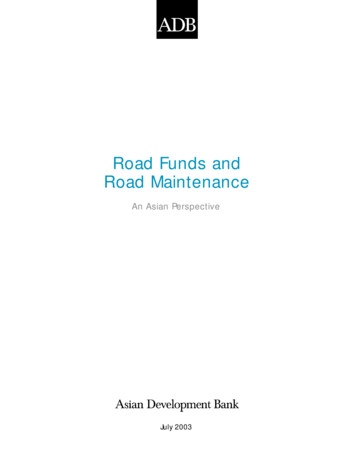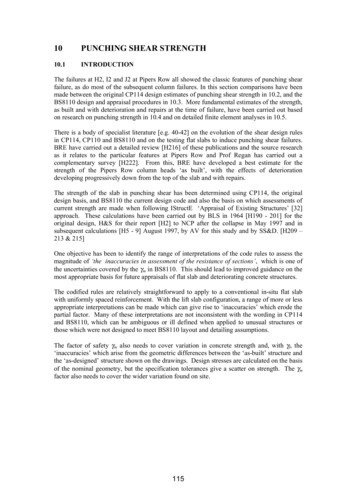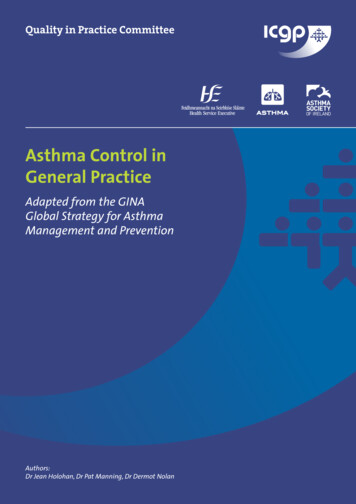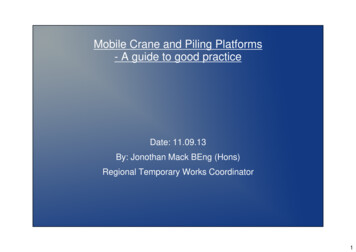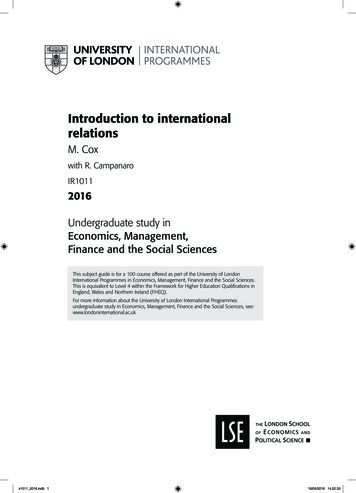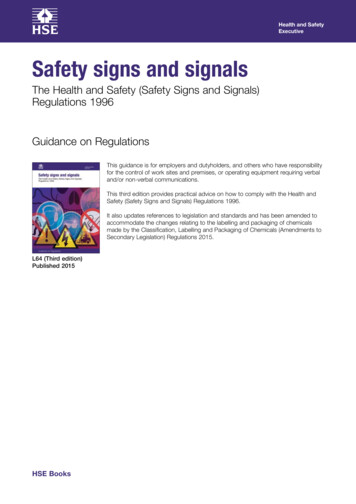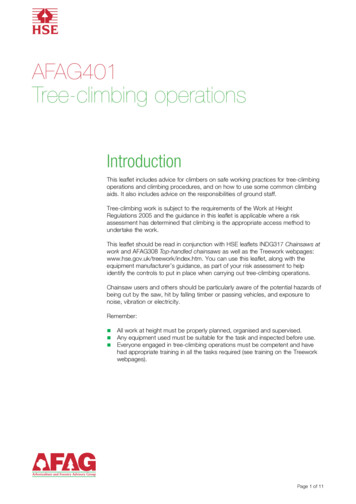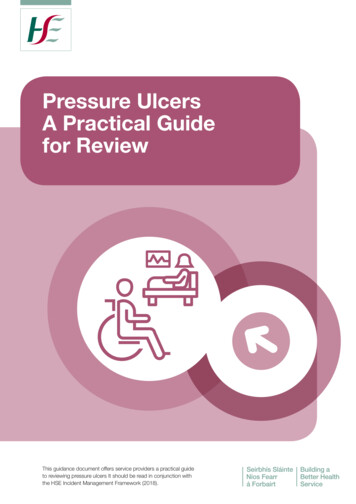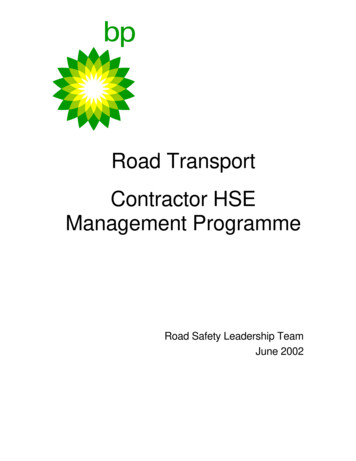
Transcription
Road TransportContractor HSEManagement ProgrammeRoad Safety Leadership TeamJune 2002
CONTRACTOR HSE MANAGEMENT PROGRAMMECONTRACTOR HSE MANAGEMENT PROGRAMMEGUIDANCE NOTEContentsPage1.0Introduction32.0Scope33.0Stages of the Contractor HSE Management Programme34.0Vetting and Selection45.0Engagement56.0Audit87.0Monitoring and Performance Evaluation98.0Glossary and Definitions9Attachments1Contractor HSE Management Programme Flow Chart112Proforma notification letters for pre-vetting purposesa)Existing Contractorsb)New Contractorsc)Additional Material for Contractor letters121415Contractor Self-assessment Questionnairea)Guide to Interpreting the Self-assessment Questionnaireb)Proforma Self-assessment Questionnaire16174Risk Assessment235Contract Road Transport Core HSE Expectations256Relationship Management267Road Transport Contractor Communications Package Reference List288Examples of things to include in contractsa)Example HSE Contract Clausesb)HSE Reporting Proformac)Termination and Reinstatement Criteria2932359Breaking a Contract; Non-existent Contract: Issues to Consider3710Sample Orientation Meeting checklist3911Types of Audits and References4412BP Group HSE Standard - Road Safety4513Technical Safety Standards – Packed Goods/Dry Bulk Heavy Vehicles5014Technical Safety Standards – Bulk Liquid Heavy Vehicles513Issued: June, 2002Page 2 of 49
CONTRACTOR HSE MANAGEMENT PROGRAMME1.0INTRODUCTIONContractors and suppliers are key to our business performance, and we will assess theircapabilities and competencies to perform work on our behalf. We will work together withthem to ensure our HSE Expectations are aligned. We will monitor contractor and partnerHSE performance, and ensure our procurement and management processes contain therigor to deliver our HSE Expectations.The focus of the Road Transport Contractor HSE Management Programme is to providethe right people, equipment and supportive environment so that the contract driver is anengaged, safe driver, making a difference on the road. Throughout this programme weshould continually ask ourselves “does this have a positive impact on the driver’sbehaviors and performance.”The Road Transport Contractor HSE Management Programme is a guidance documentdescribing a comprehensive contractor HSE management programme. Each BU isresponsible and accountable for managing its road transport contractor population. TheBU is free to use all, part or none of the tools and processes presented here. Forexample, a BU could use this document to benchmark its existing program and conduct agap analysis.2.0SCOPEThis Contractor HSE Management Programme is primarily aimed at term contractors andmore specifically term contractors with agreements with BP of greater than 12 months.While BP does not manage Branded Resellers and Jobbers, we should be settingexpectations and assuring ourselves that they are meeting those expectations. In thissense many of the tools and processes described can be used. While long-termagreements and the associated enhanced relationship between BP and the contractor ispreferred and encouraged, many BP businesses make use of spot contractors. To ensurethe best possible result where spot contractors are used, the key elements of theContractor HSE Management Programme should be applied as described below.3.0STAGES OF THE CONTRACTOR HSE MANAGEMENT PROGRAMMEThe Road Transport Contractor HSE Management Programme consists of several stagesthat enable BU management to work with the Contractor to effectively plan and completework in a way that is consistent with BP’s HSE expectations. This pack containsguidelines including a number of attachments. The attachments contain flowcharts,templates, checklists, proforma and examples of good practice that the BU may utilise /amend as it sees fit. Some activities / understandings are considered to be so important,that they have been designated as key elements and are strongly recommended to be partof any contractor management programme. These are found in the following attachments:2Letters to Contractors3 a)Self-assessment questionnaire4Risk ranking models5Core HSE Expectations8 b)HSE Reporting requirements are required to be addressed in the contractIssued: June, 2002Page 3 of 49
CONTRACTOR HSE MANAGEMENT PROGRAMMEBUs should establish a register of Contractors who have been accredited under theContractor HSE Management Programme.An overview flowchart to the programme is included in Attachment 1.Prior to implementing the Programme, the BU should have established a set of ContractorRoad Safety Policies, Standards and Procedures (PSP). These PSP would includestandards and expectations for Drivers, Light Vehicles, Heavy Good Vehicles, DrivingHours, Emergency Response, Fork Lift Truck, Maintenance Processes and ReportingGuidelines, among others. PSP should be fit for purpose, considering the risks involvedand may differ between BUs.Additionally, before initiating the RT Contractor Management Process, the BU shouldconsider its current state and scope of contractor assurance and awareness. Based onthis review, the BU may only need to strengthen its contract management program in a fewareas using these guidelines to conduct a gap analysis. Some BUs may decide to totallyrevise their programmes and some BUs will find that their current contractor Managementprogrammes are in good alignment with these guidelines.BP’s contractors are responsible for their sub-contractors (if any) meeting BP’sexpectations. Some BUs may, for business reasons, insist on giving written approvalbefore a subcontractor can be used.4.0VETTING AND SELECTIONThe vetting and selection process is about deciding whether the BU wants to considerdoing business with a new Contractor, or remain doing business with an existingContractor not presently subject to HSE assurance. At this point the Contractor is notbeing asked to bid on or conduct any work for the BU. A review of a Contractor's previousHSE experience and performance is a valuable source of information.At the end of this stage, a decision will be made whether to place the Contractor on theaccredited Contractor’s register, which will permit the Contractor to bid on work. The sameprocess can be applied for both existing and new Contractors.4.1Notification of Broad Expectations: A letter containing our basic HSE expectations,and attachment/s such as gHSEr, Global Road Safety Standards and the selfassessment questionnaire (see point 4.2), etc. The letter will be slightly different forexisting vs. new Contractors. Refer to Attachment 2 for proforma letters, and a list ofsuggested attachments to the letter.4.2Self-assessment: This questionnaire is completed by the Contractor, and sent backto the person in the BU who is considering putting the Contractor on the accreditedcontractor register. The questionnaire asks for objective information and data. Referto Attachment 3 for a proforma self-assessment questionnaire, and guidance oninterpretation.4.3Compile available information: A number of steps (some of which may be conductedin parallel) for organizing and understanding the data:a.Review of the results of the self-assessment questionnaire.Issued: June, 2002Page 4 of 49
CONTRACTOR HSE MANAGEMENT PROGRAMMEb.Consultation with ‘local intelligence’ e.g. local staff who have used theContractor before, or may know of them or their reputation through localknowledge.c.Other sources of information within the BU or industry contacts, cross-BU orcross-stream enquiries, and references.d.Using the information collected in steps a., b., and c., place the Contractoron a simple risk rank model to determine whether the likely activities orContractor (organisation) would be placed in low, medium or high riskcategories. Samples of simple risk rank models are included inAttachment 4.e.Following data gathering (self-assessment questionnaire) and riskassessment (e.g. the Latin American Lubricants PU’s Risk Model –Attachment 4), a verification visit to the Contractor must be conducted toassess Contractor facilities, HSE systems and operations. The verificationvisit should be fit-for-purpose. An extensive audit is not necessary at thispoint. This visit can also be a good starting point for the engagementprocess.4.4Make selection decision: Does it feel right? The manager responsible for the location / business hiring the Contractormakes the determination of a Contractor's ability to work safely. The same process is applied whether the Contractor is new or existing. If the Contractor passes the vetting and is selected, it will be entered onto theaccredited Contractor register.5.0ENGAGEMENTOnce the BU has vetted and selected a Contractor, the process of Engagement begins.This process is a targeted communications effort to engage the Road Transport Contractorand, ultimately, the Driver on whom the transport movement depends.An important ingredient for the engagement process to be successful is that BUmanagement must demonstrate clear and consistent leadership in the area of contractroad transport. Some examples include: Driver ride-alongs ASAs related to road safety Leading by good example (e.g. seat belt use and proper use of mobile phones) Recognizing good behaviours and demonstrating constructive intolerance of badbehavioursThis type of leadership will create a positive and supportive environment for BU staff towork with the Road Transport Contractor to successfully implement this programme.Additionally, the BU can demonstrate their interest in Contractor operations by designatinga BP Representative with the authority to manage the contractor relationship, including theauthority to suspend or terminate Contractor activities in accordance with the contract. AsIssued: June, 2002Page 5 of 49
CONTRACTOR HSE MANAGEMENT PROGRAMMEan example of good practice in use in BP, a Contractor Account Manager (CAM) processis described below. BUs can choose to implement this or similar programmes, dependingon the nature and requirements of their specific business. For example, a BU might use ateam of individuals to manage the CAM’s responsibilities described in the next section.The Contractor Account Manager (CAM) plays a critical leadership role in setting the toneand leading the engagement process with the Contractor.The CAM:1. Owns the relationship with the Contractor: Is primary focal point within BP for all road safety issues with the Contractor Develops a working relationship with the Contractor’s senior management, andpeople at all levels of the organisation Builds trust and respect Understands the Contractor’s business, including challenges2. Engages the Contractor using conversation, positive actions and passion, with thegoal of influencing the development of a positive safety culture within theContractor organisation, promoting safety culture and a safe working environment.3. Conducts a gap analysis, with the Contractor, using the standards andexpectations as outlined in the BU s Road Transport Standards and Expectationsand agrees an action plan with milestones.4. Coordinates regular monitoring and performance reviews and audits. The CAMplays a key role regarding the assurance of safety commitment and theperformance of the Contractor.5. Consistently reinforces to the Contractor the consequences of not complying withthe requirements of the program, including awareness of the disciplinary process.If necessary, the CAM constructively administers disciplinary action (e.g.investment in training).6. Is able to provide assurance (“testify”) on behalf of the Contractor to the BUorganisation. The CAM will be the main sponsor of the Contractor for the BUregarding their attitude, record, infrastructure and assurance of the Road TransportProgramme Standards & Expectations.In summary, The CAM is responsible for ensuring that the Road Transport Contractor hasa full understanding of our HSE expectations, and for forging mutual agreement about howthose expectations will be applied in a contractual relationship covering the actual workthat the Contractor will perform. CAMs need to receive specific training considering theywill play a critical role of leading the engagement process with the Contractor. CAMs willbe given guidance as to how the Programme is conducted for Contractors of various sizesand levels of sophistication. An outline of the framework, training programme, andchecklist of supporting material for the CAM’s training is contained in Attachment 6 –Relationship Management.Typically it is at this point that a contract would be executed and all of the expectations,commitments (from both BP and the Contractor) and relationships would be documented.Issued: June, 2002Page 6 of 49
CONTRACTOR HSE MANAGEMENT PROGRAMMEIf the Contractor is simply going onto an approved / accredited Contractor list, anagreement covering potential services and expectations could be executed.5.1Pre-bid or pre-work meeting/s: These meetings are critical in setting the context forHSE assurance, and the basis for relationship management going forward. Themeeting/s need to include an overview of the Contractor Management Programme,and a review of detailed HSE expectations relevant to the scope of work / services tobe provided. Once negotiations are completed, the contract will record theagreements and how the ongoing relationship will work.Core HSE expectations for Road Transport Contractors are contained inAttachment 5.A Reference List to various Contractor communications slide packs developed withinBP Group is contained in Attachment 7.Attachment 8 contains a number of things that can be included in contracts: Sample HSE contract clauses for a variety of different type of Contractors Reporting requirements Termination and Reinstatement procedures5.2Verification Visit: A verification visit must be conducted (see section 3.0) as part ofthe engagement process. Any agreement on action plans and milestones resultingfrom this visit must be recorded in the contract or related documents.5.3Exist
7 Road Transport Contractor Communications Package Reference List 28 8 Examples of things to include in contracts a) Example HSE Contract Clauses 29 b) HSE Reporting Proforma 32 c) Termination and Reinstatement Criteria 35 9 Breaking a Contract; Non-existent Contract: Issues to Consider 37 10 Sample Orientation Meeting checklist 39
